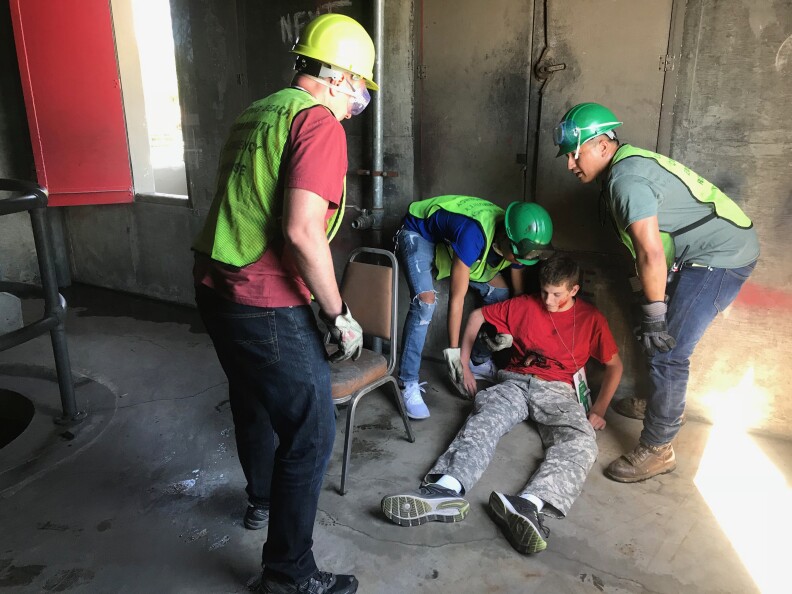Los Angeles is one of the most disaster prone cities in the world, vulnerable to earthquakes, fires and many other disasters. So it shouldn't come as a surprise that Community Emergency Response Training, or CERT, started here.
Designed to teach regular people how to be first responders, it's now a national program made available through the Federal Emergency Management Agency, which recognized the CERT program in Long Beach last year for outstanding community preparedness.
Over the weekend, CERT Long Beach ran a mock disaster drill, simulating a 7.6 earthquake in L.A. County. It's the earthquake everyone has been dreading. You check yourself and you’re ok, so you wander into the street. Cars are flipped over and fires are smoldering. You start to hear people screaming.
You see a six-story building that looks partially destroyed, black from fire. You walk into the building and hear a little boy screaming for help, his voice echoing in the stairwell.
Then you see three men with hard hats, protective glasses and neon green vests. They yell.
“Long Beach CERT. Anyone in here?”
So this isn’t actually the big one. It’s the Community Emergency Response Training drill (CERT) with the Long Beach Fire Department. But for many of the participants it feels really real.

Three emergency response trainees have found a teenage boy who's pretending that his right abdomen is impaled by a stick. His injuries look pretty real. The trainees are learning how to assess victims, to properly transport them and perform basic triage. In this case, they lift the boy onto a chair and then down the stairs.

“This event is really designed to push them and make them work together as a team: to come together to provide first aid, search and rescue and medical and fire suppression,” says Jake Heflin, CERT’s program manager and a firefighter with the Long Beach Fire Department for 18 years.
The training drill is filled with victims wandering around screaming for help and others hidden under cars or machinery. It’s chaotic, just like it would be in a real disaster, especially at the makeshift triage center.


There's a guy with third degree burns all over his body and others with glass in their arms and blood all over them. These injuries aren’t real; they’re the work of moulage artists who apply fake injuries. Heflin says moulage artists and volunteer victims who act out their parts are very important to the drill because it gives participants a sense of realism and urgency.

Today's drill is the culmination of two full days of training. It's based on real life estimates of a 7.8 magnitude earthquake hitting Southern California. A disaster like that would kill around 2,000 people and injure another 50,000. It would also cause billions of dollars of damage, destroying freeways and leaving the region without gas, electricity and water. Earthquakes of this magnitude have historically occurred every 150 years in the region. It's been 300 since the last one. Long Beach CERT is working to make sure its community will be ready.

The training is designed to give ordinary folks the tools to save lives. Heflin says there are 124 fire fighters on duty on any given day in Long Beach. The city has half a million residents. That's roughly one firefighter for every 5,000 people. He says when (not if) disaster hits, the fire department will absolutely be overwhelmed

“We will rely on volunteers that are trained in CERT, other volunteers that are passionate about contributing to the community to support and assist those in need -- to be able to rally, to be able come together do the greatest good for the greatest number of people in the shortest amount of time,” Heflin says.

'The greatest good for the greatest number of people’ is CERT's motto. In an emergency, fire fighters will get a lot of calls for help and they will go where the damage is most severe and the greatest amount of people need help -- a collapsed school with 100 trapped kids, for example, instead of a house with five people trapped. So who’s going to help those five people?

CERT is the fire department's 'force multiplier.' It's their way of training the community to be able to take care of itself in a disaster. After the drill, many participants say they feel empowered.
“It makes me feel like, okay instead of fear being my first instinct, react and respond and see, okay what's our plan? Plan, not fear, [that’s a] big difference," says Danica Potts.

During the drill she successfully put out a fire, saved two people’s lives and applied emergency medical aid to someone with broken ribs. Two days ago, Potts was just an ordinary community member with no idea how to preform these tasks.

The skills participants learn will help not only in a disaster but in everyday situations like putting out a fire—before it engulfs a home, then a street and potentially a neighborhood—stopping disaster before it starts. One study Heflin sited said that for every $1 spent on preparation, we save $6 in response recovery money.

In 2017, Long Beach CERT won FEMA’s national award for the Outstanding Community Emergency Response Team Initiatives award. More than 1,000 people have graduated from CERT programs in Long Beach since they started. You just never know when the big one's coming, but what we do know is that luck favors the prepared.



